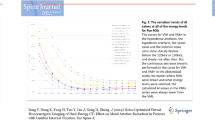Abstract
Objectives
To evaluate optimal monoenergetic dual-energy computed tomography (DECT) settings for artefact reduction of posterior spinal fusion implants of various vendors and spine levels.
Methods
Posterior spinal fusion implants of five vendors for cervical, thoracic and lumbar spine were examined ex vivo with single-energy (SE) CT (120 kVp) and DECT (140/100 kVp). Extrapolated monoenergetic DECT images at 64, 69, 88, 105 keV and individually adjusted monoenergy for optimised image quality (OPTkeV) were generated. Two independent radiologists assessed quantitative and qualitative image parameters for each device and spine level.
Results
Inter-reader agreements of quantitative and qualitative parameters were high (ICC = 0.81–1.00, κ = 0.54–0.77). HU values of spinal fusion implants were significantly different among vendors (P < 0.001), spine levels (P < 0.01) and among SECT, monoenergetic DECT of 64, 69, 88, 105 keV and OPTkeV (P < 0.01). Image quality was significantly (P < 0.001) different between datasets and improved with higher monoenergies of DECT compared with SECT (V = 0.58, P < 0.001). Artefacts decreased significantly (V = 0.51, P < 0.001) at higher monoenergies. OPTkeV values ranged from 123–141 keV. OPTkeV according to vendor and spine level are presented herein.
Conclusions
Monoenergetic DECT provides significantly better image quality and less metallic artefacts from implants than SECT. Use of individual keV values for vendor and spine level is recommended.
Key Points
• Artefacts pose problems for CT following posterior spinal fusion implants.
• CT images are interpreted better with monoenergetic extrapolation using dual-energy (DE) CT.
• DECT extrapolation improves image quality and reduces metallic artefacts over SECT.
• There were considerable differences in monoenergy values among vendors and spine levels.
• Use of individualised monoenergy values is indicated for different metallic hardware devices.




Similar content being viewed by others
References
Ponnusamy KE, Iyer S, Gupta G, Khanna AJ (2011) Instrumentation of the osteoporotic spine: biomechanical and clinical considerations. Spine J 11:54–63
Cheng JS, Lee MJ, Massicotte E et al (2011) Clinical guidelines and payer policies on fusion for the treatment of chronic low back pain. Spine (Phila Pa 1976) 36:S144–S163
Willems P, de Bie R, Oner C, Castelein R, de Kleuver M (2011) Clinical decision making in spinal fusion for chronic low back pain. Results of a nationwide survey among spine surgeons. BMJ Open 1:e000391
Wood KB, Fritzell P, Dettori JR, Hashimoto R, Lund T, Shaffrey C (2011) Effectiveness of spinal fusion versus structured rehabilitation in chronic low back pain patients with and without isthmic spondylolisthesis: a systematic review. Spine (Phila Pa 1976) 36:S110–S119
Sucato DJ (2010) Management of severe spinal deformity: scoliosis and kyphosis. Spine (Phila Pa 1976) 35:2186–2192
Young PM, Berquist TH, Bancroft LW, Peterson JJ (2007) Complications of spinal instrumentation. Radiographics 27:775–789
Murtagh RD, Quencer RM, Castellvi AE, Yue JJ (2011) New techniques in lumbar spinal instrumentation: what the radiologist needs to know. Radiology 260:317–330
Douglas-Akinwande AC, Buckwalter KA, Rydberg J, Rankin JL, Choplin RH (2006) Multichannel CT: evaluating the spine in postoperative patients with orthopedic hardware. Radiographics 26:S97–S110
Barrett JF, Keat N (2004) Artifacts in CT: recognition and avoidance. Radiographics 24:1679–1691
Buckwalter KA, Parr JA, Choplin RH, Capello WN (2006) Multichannel CT imaging of orthopedic hardware and implants. Semin Musculoskelet Radiol 10:86–97
Kachelriess M, Watzke O, Kalender WA (2001) Generalized multi-dimensional adaptive filtering for conventional and spiral single-slice, multi-slice, and cone-beam CT. Med Phys 28:475–490
Veldkamp WJ, Joemai RM, van der Molen AJ, Geleijns J (2010) Development and validation of segmentation and interpolation techniques in sinograms for metal artifact suppression in CT. Med Phys 37:620–628
Flohr TG, McCollough CH, Bruder H et al (2006) First performance evaluation of a dual-source CT (DSCT) system. Eur Radiol 16:256–268
Yu H, Zeng K, Bharkhada DK et al (2007) A segmentation-based method for metal artifact reduction. Acad Radiol 14:495–504
Bamberg F, Dierks A, Nikolaou K, Reiser MF, Becker CR, Johnson TR (2011) Metal artifact reduction by dual energy computed tomography using monoenergetic extrapolation. Eur Radiol 21:1424–1429
Zhou C, Zhao YE, Luo S et al (2011) Monoenergetic imaging of dual-energy CT reduces artifacts from implanted metal orthopedic devices in patients with factures. Acad Radiol 18:1252–1257
Menze M (2009) Spine revenues up 11.1%. New trend? In: Pearldiver technologies. S. Ellison. Available via http://www.pearldiverinc.com/pdi/articles.jsp?q=/var/www/html/pearldiver/market/spine/html/Spine-Revenues-Up-11-percent-New-Trend-09-16-09.html&t=Spine+Revenues+Up+11+percent+−+New+Trend?&c=spine
Stolzmann P, Leschka S, Scheffel H et al (2010) Characterization of urinary stones with dual-energy CT: improved differentiation using a tin filter. Invest Radiol 45:1–6
Landis JR, Koch GG (1977) The measurement of observer agreement for categorical data. Biometrics 33:159–174
Haramati N, Staron RB, Mazel-Sperling K et al (1994) CT scans through metal scanning technique versus hardware composition. Comput Med Imaging Graph 18:429–434
Lee MJ, Kim S, Lee SA et al (2007) Overcoming artifacts from metallic orthopedic implants at high-field-strength MR imaging and multi-detector CT. Radiographics 27:791–803
Acknowledgements
The authors wish to thank the product specialists T. Frommenwiler (Braun®), M. Schroeder (DePuy®), A. Gertsch (Medtronic®) and G. Guaresi (Stryker®) for their support, and all participating vendors (including Synthes®) for providing us with spinal fusion implants and product specifications.
Author information
Authors and Affiliations
Corresponding author
Rights and permissions
About this article
Cite this article
Guggenberger, R., Winklhofer, S., Osterhoff, G. et al. Metallic artefact reduction with monoenergetic dual-energy CT: systematic ex vivo evaluation of posterior spinal fusion implants from various vendors and different spine levels. Eur Radiol 22, 2357–2364 (2012). https://doi.org/10.1007/s00330-012-2501-7
Received:
Revised:
Accepted:
Published:
Issue Date:
DOI: https://doi.org/10.1007/s00330-012-2501-7




